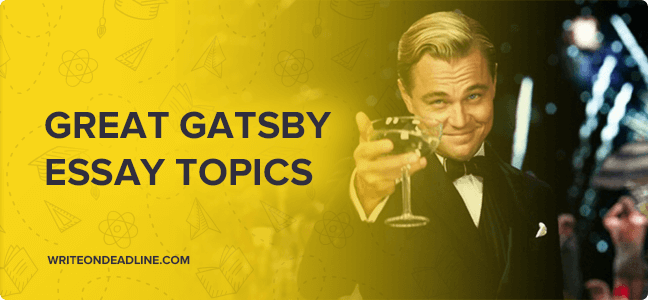100+ Great Gatsby Essay Topics

Table of Contents
The Great Gatsby Essay Topics: Dive Deep into Fitzgerald’s World
When F. Scott Fitzgerald penned “The Great Gatsby,” he probably didn’t foresee the cultural phenomenon it would become. It’s not just a story about the Roaring Twenties, but a timeless exploration of ambition, love, societal pressures, and the ever-elusive American Dream. As students and literature enthusiasts, analyzing this classic novel can lead to intriguing insights.
What is a Great Gatsby Essay?
A “Great Gatsby” essay is an analytical or argumentative piece that delves into the themes, characters, symbols, and narrative techniques in Fitzgerald’s novel. From the opulent parties at Gatsby’s mansion to the faded eyes of Dr. T. J. Eckleburg on a billboard, the novel offers a plethora of subjects ripe for exploration.
Guide to Choosing a Great Gatsby Essay Topic
When it comes to picking the perfect topic for your “Great Gatsby” essay, think about what fascinates you the most about the novel. Is it a particular character’s arc, a recurring symbol, or a central theme? Consider:
- Your Passion: Choose a topic that genuinely intrigues you. This will make your writing process more enjoyable.
- Relevance: If your essay has specific guidelines, make sure your topic aligns with them.
- Scope: Ensure your topic is neither too broad nor too narrow. It should allow for a deep dive without overwhelming.
Great Gatsby Essay Topics Lists
Character Analysis
- The evolution of Jay Gatsby: From James Gatz to the Golden Boy
- Daisy Buchanan: A symbol of the American Dream or its victim?
- The duality of Tom Buchanan: Aristocratic charm and brutish behavior
- Jordan Baker: The modern woman of the 1920s
- The tragic trajectory of George and Myrtle Wilson
Themes Explored
- The decay of the American Dream
- The superficiality of the Jazz Age
- The role of wealth and class
- The portrayal of love and obsession
- Morality and corruption in the Roaring Twenties
Symbols and Motifs
- The green light: Hope, dreams, and unattainable desires
- The Valley of Ashes: Decay, despair, and the downtrodden
- Dr. T. J. Eckleburg’s eyes: The omnipresent moral judgment
- Cars in the novel: Symbols of status, freedom, and impending doom
- East vs. West: The inherent tension and their symbolic meanings
Narrative Techniques
- The reliability of Nick Carraway as a narrator
- Fitzgerald’s use of color symbolism
- The role of setting in character development
- The significance of the title: Who is the “Great” Gatsby?
- The structure of the novel and its impact on the narrative
Character Insights
- The metamorphosis of James Gatz to Jay Gatsby: A self-made illusion
- The allure and tragedy of Daisy Buchanan
- Tom Buchanan: The embodiment of 1920s excess and entitlement
- The enigmatic charm of Jordan Baker
- George Wilson: A product of societal neglect
- Myrtle Wilson’s desperate grasp for a luxurious life
- Meyer Wolfsheim and the underworld of the Jazz Age
- The subtle influences of Catherine, Myrtle’s sister
Exploring Central Themes
- The ephemeral nature of the American Dream
- Love versus obsession: Gatsby’s pursuit of Daisy
- Moral decay in the heart of the Jazz Age
- The consequences of unchecked ambition
- Illusion vs. reality: The facades characters maintain
- The societal clash: Old Money vs. New Money
- The isolation and loneliness lurking beneath the parties
Symbols and Their Interpretations
- The elusive green light and its manifold meanings
- The Valley of Ashes: The grim face of industrialization
- The haunting eyes of Dr. T. J. Eckleburg
- The significance of Gatsby’s lavish parties
- The role of automobiles: Symbols of modernity and death
- The shirts and materialism: Daisy’s emotional collapse
Narrative Techniques & Structure
- Assessing Nick Carraway’s reliability as a narrator
- Fitzgerald’s prose: A blend of poetic and prosaic
- The non-linear timeline and its effects on suspense
- The role of weather and its influence on the narrative mood
- Foreshadowing in the novel: Predicting Gatsby’s downfall
Comparative Analyses
- “The Great Gatsby” and the plays of Tennessee Williams: A study in Southern Gothic
- Comparing Daisy Buchanan and Blanche DuBois
- The Jazz Age in “The Great Gatsby” vs. “This Side of Paradise”
- Comparing the tragedies of Jay Gatsby and Oedipus Rex
- The portrayal of the American Dream in “The Great Gatsby” vs. “Death of a Salesman”
Societal Implications
- The role of women in “The Great Gatsby”: Traditionalism vs. Modernism
- Racism and xenophobia: The dark undertones of the Jazz Age
- The impact of Prohibition on the characters and plot
- Jazz music and its influence on the Roaring Twenties ethos
- The disillusionment of World War I veterans: Gatsby’s hidden scars
Miscellaneous Topics
- The significance of the Midwest vs. the East Coast
- The influence of Gatsby’s father and his cameo in the novel
- Analyzing the epigraph: Why “Then wear the gold hat”?
- The role of minor characters in building Gatsby’s world
- The cultural legacy of “The Great Gatsby” in modern media
Unraveling Relationships
- Gatsby and Nick: A friendship built on admiration and intrigue
- The love triangle: Gatsby, Daisy, and Tom
- The tragic love affair of George and Myrtle Wilson
- Tom and Myrtle: Lust, power, and socioeconomic dynamics
- The nuanced relationship between Nick and Jordan
Behind the Illusions
- The significance of Gatsby’s Oxford photograph and medal
- The root of Gatsby’s wealth: Ill-gotten gains and their implications
- The role of gossip and rumors in shaping perceptions
- The real reason behind Gatsby’s infatuation with Daisy
- The illusion of East Egg’s sophistication and its moral bankruptcy
Contextual Analysis
- The influence of the Lost Generation on Fitzgerald’s narrative
- The impact of the stock market and economic dynamics on the story’s backdrop
- Jazz, flappers, and the cultural shifts of the 1920s
- The role of organized crime and its influence on the novel’s events
- The societal implications of prohibition in the Roaring Twenties
Deeper Dive into Symbols
- The significance of the color yellow in the novel
- Gatsby’s mansion as a symbol of his ambitions and insecurities
- The motif of water and barriers in Gatsby and Daisy’s relationship
- The broken clock during Gatsby’s reunion with Daisy
- The juxtaposition of fire and water in the novel’s climax
Literary Legacy
- The influence of “The Great Gatsby” on modern American literature
- Adapting “The Great Gatsby”: Comparing the novel to its film adaptations
- “The Great Gatsby” in popular culture: References, homages, and parodies
- The continued relevance of “The Great Gatsby” in the 21st century
- How “The Great Gatsby” reflects the cyclical nature of societal excess and downfall
Call to Action
Feeling overwhelmed? Our essay writing service at writeondeadline.com is here to help! Whether you need assistance in topic selection, research, or the entire essay, our team of experts can craft the perfect piece tailored to your needs.
Useful References:
- The Great Gatsby, F. Scott Fitzgerald – Read the full novel for free on Project Gutenberg.
- F. Scott Fitzgerald and the American Dream – A deep dive into the author’s perspective on the American Dream.
- The Roaring Twenties and The Great Gatsby – Understand the historical context of the novel.

